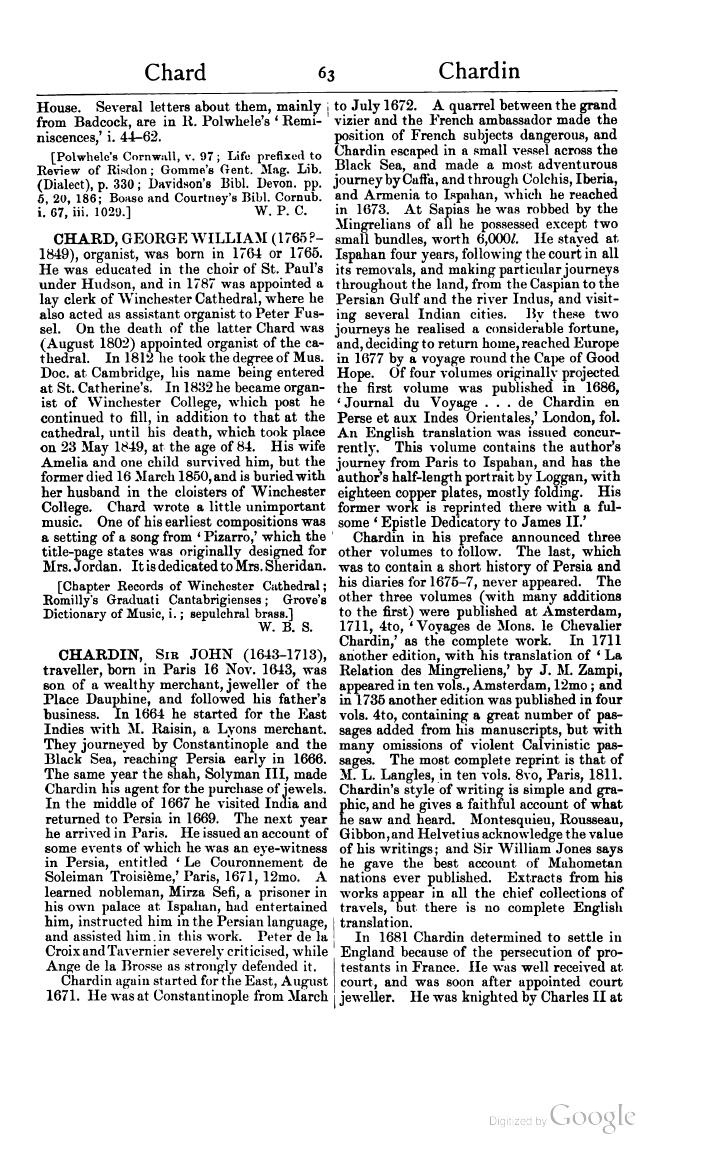House. Several letters about them, mainly from Badcock, are in R. Polwhele’s ‘Reminiscences,' i. 44-62.
[Polwhele's Cornwall, v. 97; Life prefixed to Review of Risdon; Gomme's Gent. Mag. Lib. (Dialect), p. 330; Davidson’s Bibl. Devon. pp. 5, 20, 186; Boase and Courtney's Bibl. Cornub. i. 67, iii. 1029.]
CHARD, GEORGE WILLIAM (1765?–1849), organist, was born in 1764 or 1765. He was educated in the choir of St. Paul's under Hudson, and in 1787 was appointed a lay clerk of Winchester Cathedral, where he also acted as assistant organist to Peter Fussel. On the death of the latter Chard was (August 1802). appointed organist of the cathedral. In 1812 he took the degree of Mus. Doc. at Cambridge, his name being entered at St. Catherine's. In 1832 he became organist of Winchester College, which post he continued to fill, in addition to that at the cathedral, until his death, which took place on 23 May 1849, at the age of 84. His wife Amelia and one child survived him, but the former died 16 March 1850,and is buried with her husband in the cloisters of Winchester College. Chard wrote a little unimportant music. One of his earliest compositions was a setting of a song from ‘Pizarro,’ which the title-page states was originally designed for Mrs. Jordan. It is dedicated to Mrs. Sheridan.
[Chapter Records of Winchester Cathedral; Rom11ly's Graduati Cantabrigienses; Grove's Dictionary of Music, i.; sepulchral brass]
CHARDIN, Sir JOHN (1643–1713), traveller, born in Paris 16 Nov. 1643, was son of a wealthy merchant, jeweller of the Place Dauphine, and followed his father's business. In 1664 he started for the East Indies with M. Raisin, a Lyons merchant. They journeyed by Constantinople and the Black Sea, reaching Persia early in 1666. The same year the shah, Solyman III, made Chardin his agent for the purchase of jewels. In the middle of 1867 he visited India and returned to Persia in 1869, The next year he arrived in Paris. He issued an account of some events of which he was an eye-witness in Persia, entitled ‘Le Couronnement de Soleiman Troisième,’ Paris, 1671, 12mo. A learned nobleman, Minza Sefi, a prisoner in his own palace at Ispahan, had entertained him, instructed him in the Persian language,and assisted him in this work. Peter de la Croix and Tavernier severely criticised, while Ange de la Brosse as strongly defended it.
Chardin again started for the East, August 1671. He was at Constantinople from March to July 1672. A quarrel between the grand vizier and the French ambassador made the position of French subjects dangerous, and Chardin escaped in a small vessel across the Black Sea, and made a most adventurous journey by Caffa, and through Colchis, Iberia, and Armenia to Ispahan, which he reached in 1673. At Sapias he was robbed by the Mingrelians of all he possessed except two small bundles, worth 6,000l. He stayed at Ispahan four years, following the court in all its removals, and making particular journeys throughout the land, from the Caspian to the Persian Gulf and the river Indus, and visiting several Indian cities. By these two journeys he realised a considerable fortune, and, deciding to return home, reached Europe in 1677 by a voyage round the Cape of Good Hope. Of four volumes originally projected the first volume was published in 1686, ‘Journal du Voyage … de Chardin en Parse et aux Indes Orientales,’ London, fol. An English translation was issued concurrently. This volume contains the author’s journey from Paris to Ispahan, and has the author's half-length portrait by Loggan, with eighteen copper plates, mostly folding. His former work is reprinted there with a fulsome ‘Epistle Dedicatory to James II.’
Chardin in his preface announced three other volumes to follow. The last, which was to contain a short history of Persia and his diaries for 1675–7, never appeared. The other three volumes (with many additions to the first) were published at Amsterdam, 1711, 4to, ‘Voyages de Mons. le Chevalier Chardin,’ as the complete work. In 1711 another edition, with his translation of ‘La Relation des Mingreliens,’ by J. M, Zampi, appeared in ten vols., Amsterdam, 12mo; and in 1735 another edition was published in four vols. 4to, containing a great number of passages added from his manuscripts, but with many omissions of violent Calvinistic passages. The most complete reprint is that of M. L. Langles, in ten vols. 8vo, Paris, 1811. Chardin's style of writing is simple and graphic, and he gives a faithful account of what he saw and heard. Montesquieu, Rousseau, Gibbon, and Helvetius acknowledge the value of his writings; and Sir William Jones says he gave the best account of Mahometan nations ever published. Extracts from his works appear in all the chief collections of travels, but there is no complete English translation.
In 1681 Chardin determined to settle in England because of the persecution of protestants in France. He was well received at court, and was soon after appointed court jeweller. He was knighted by Charles II at
